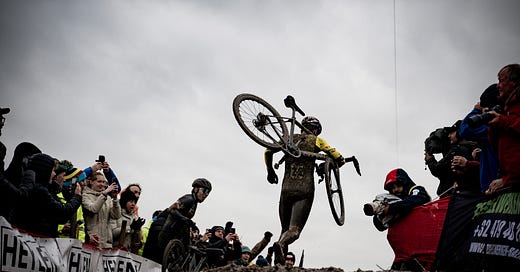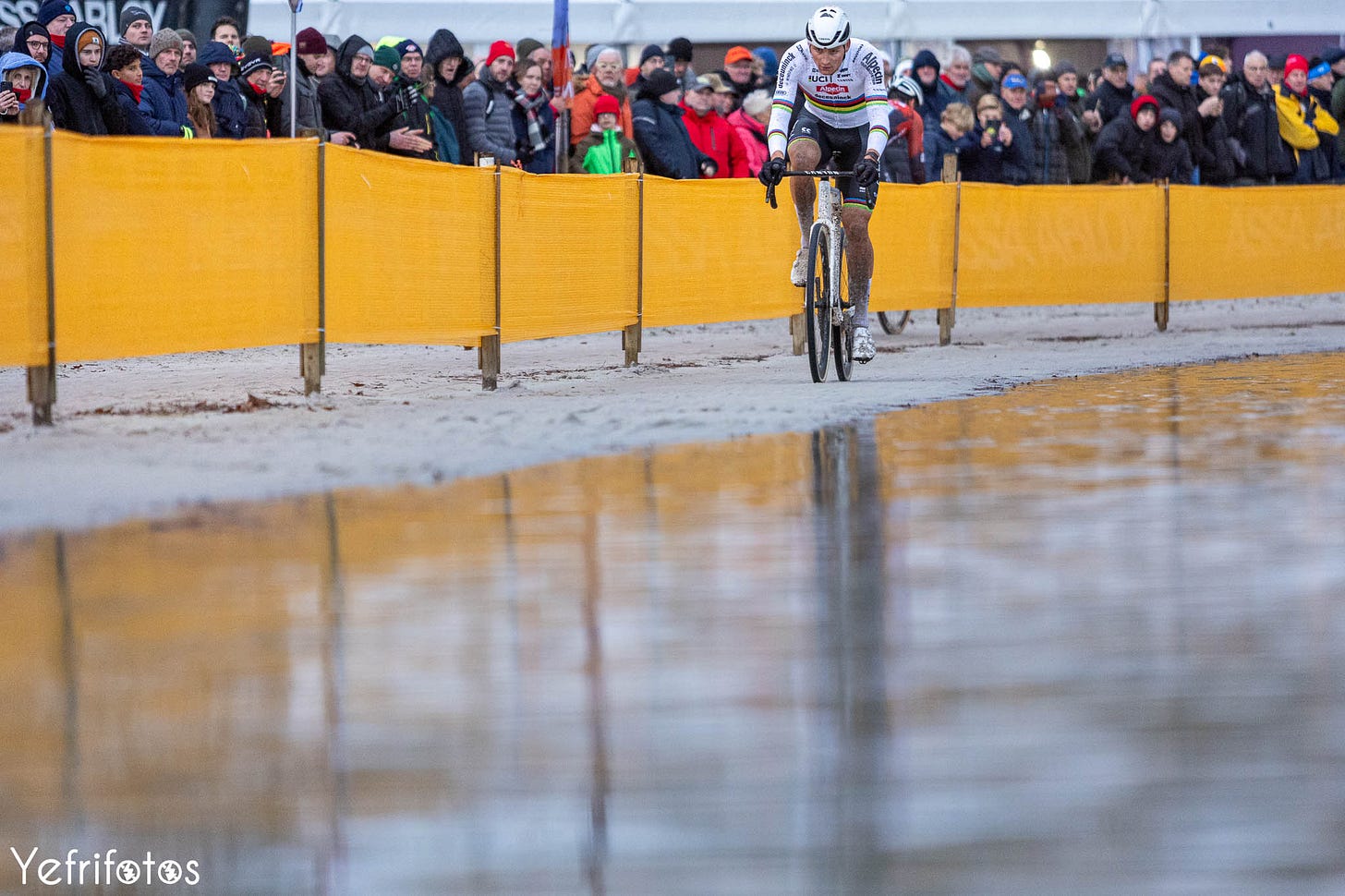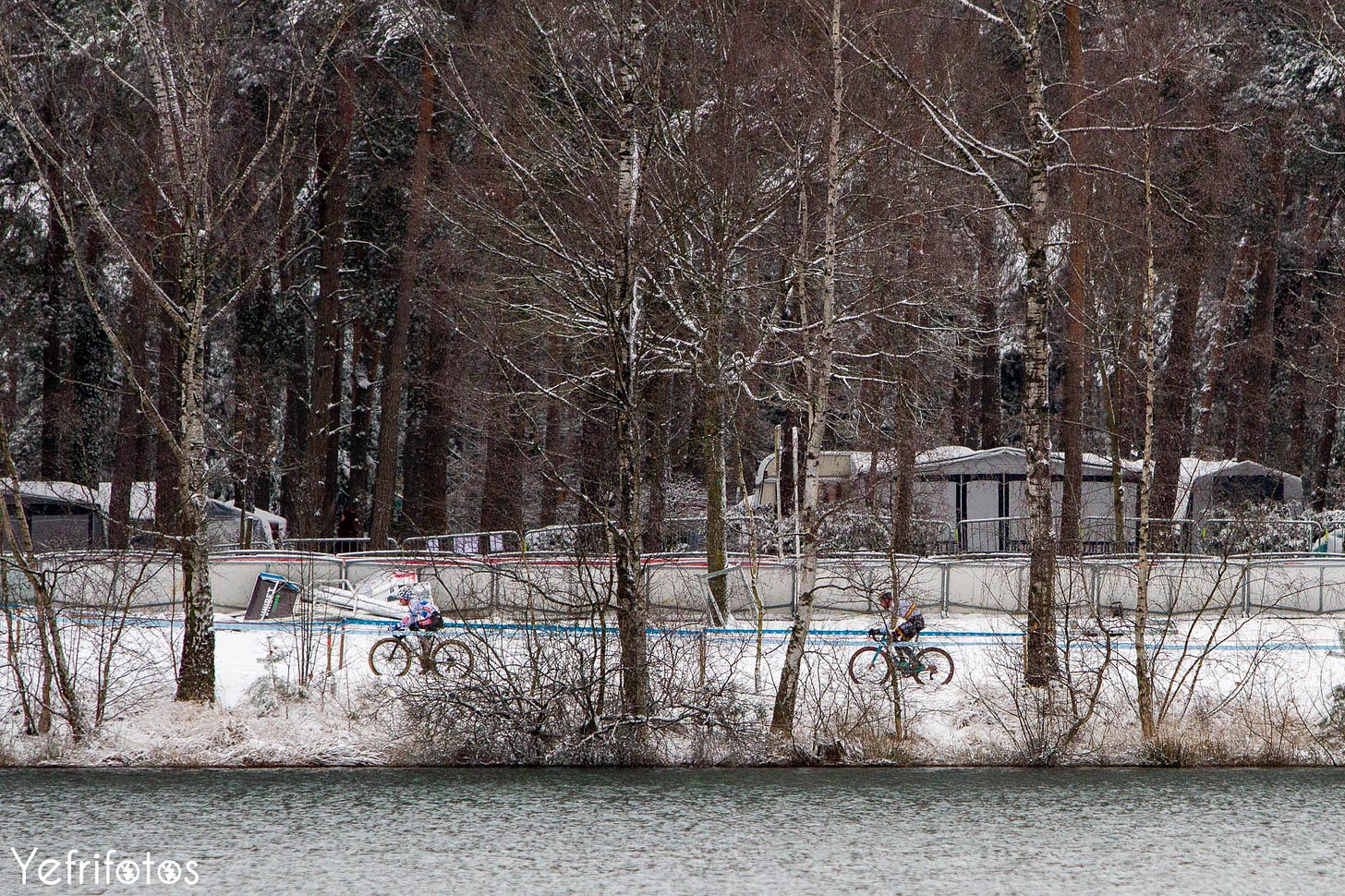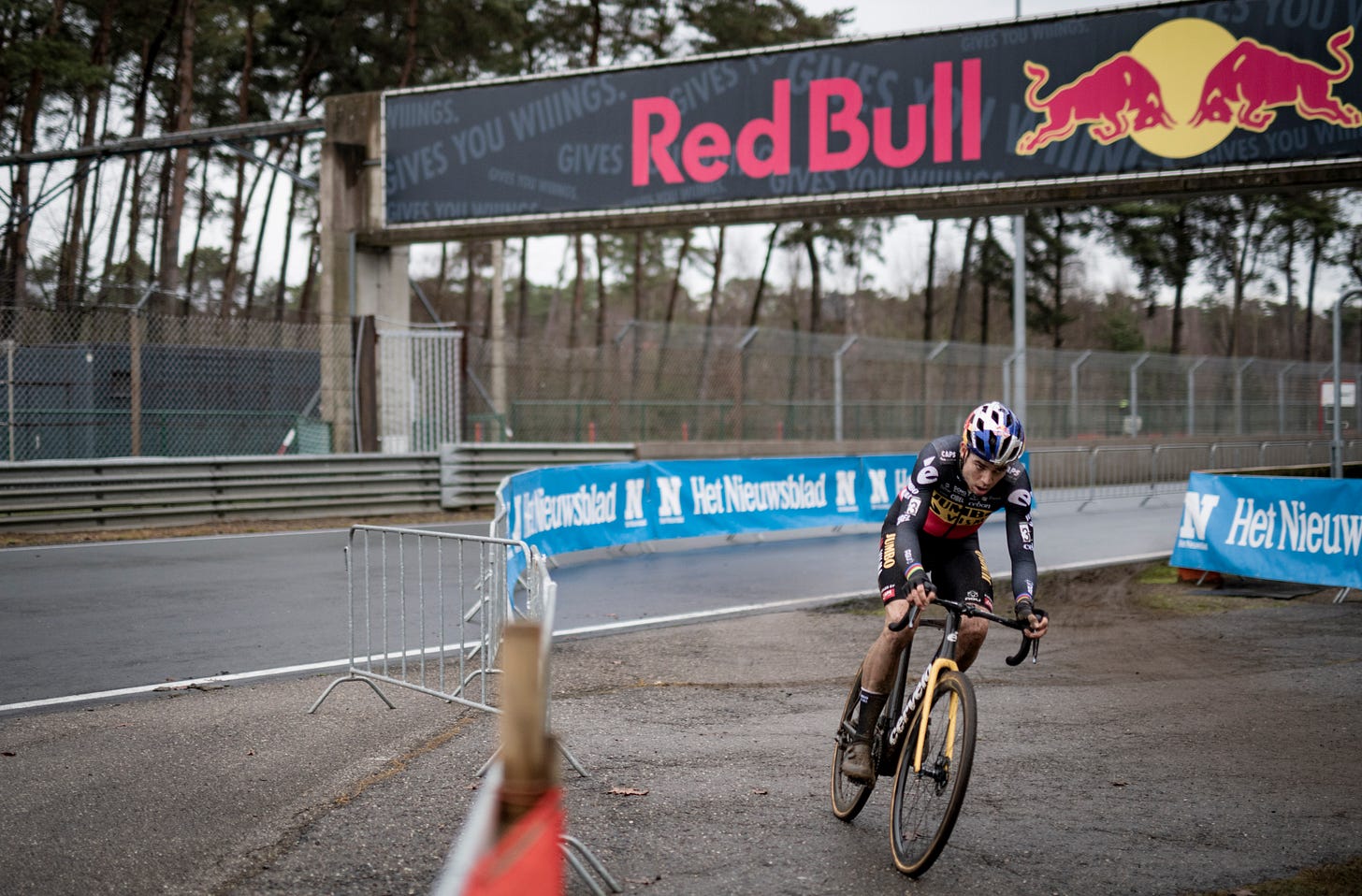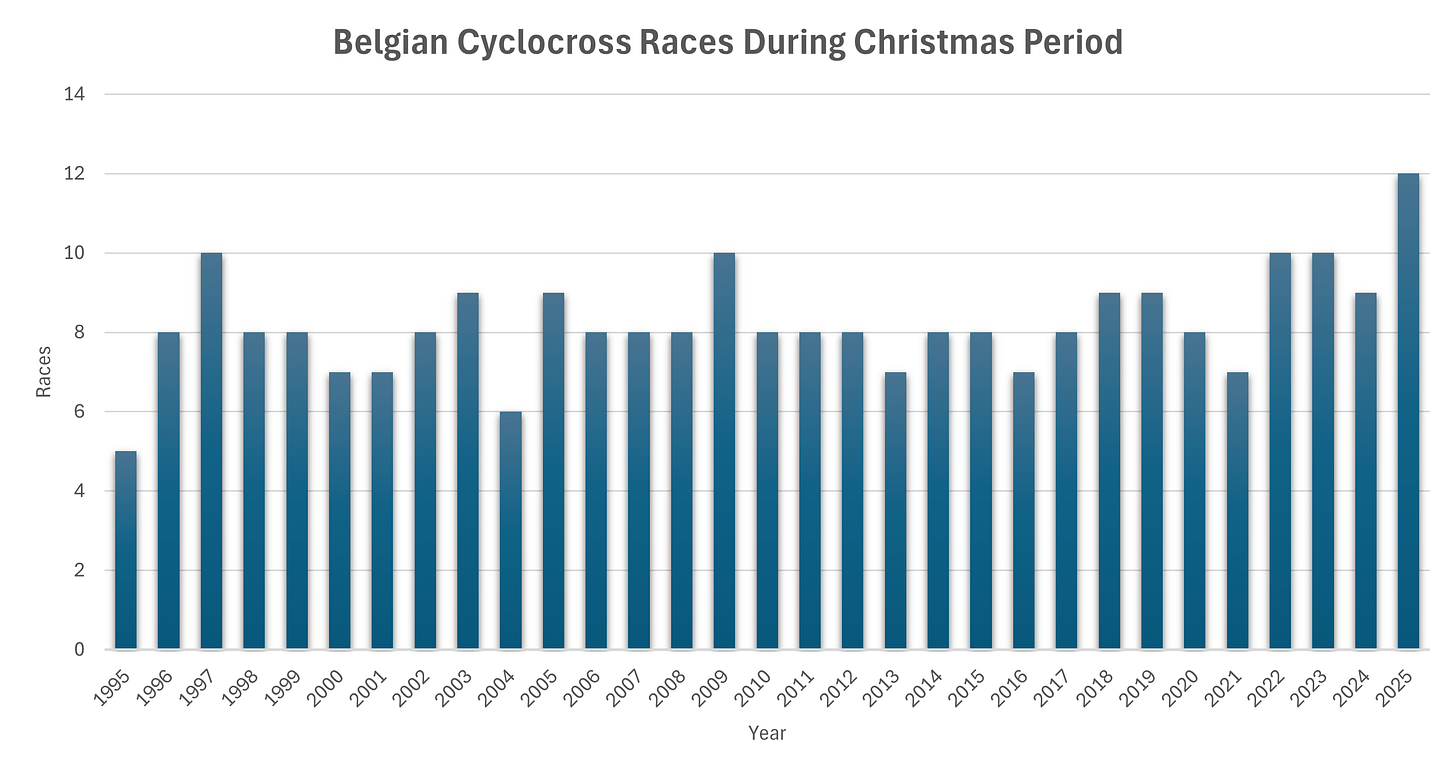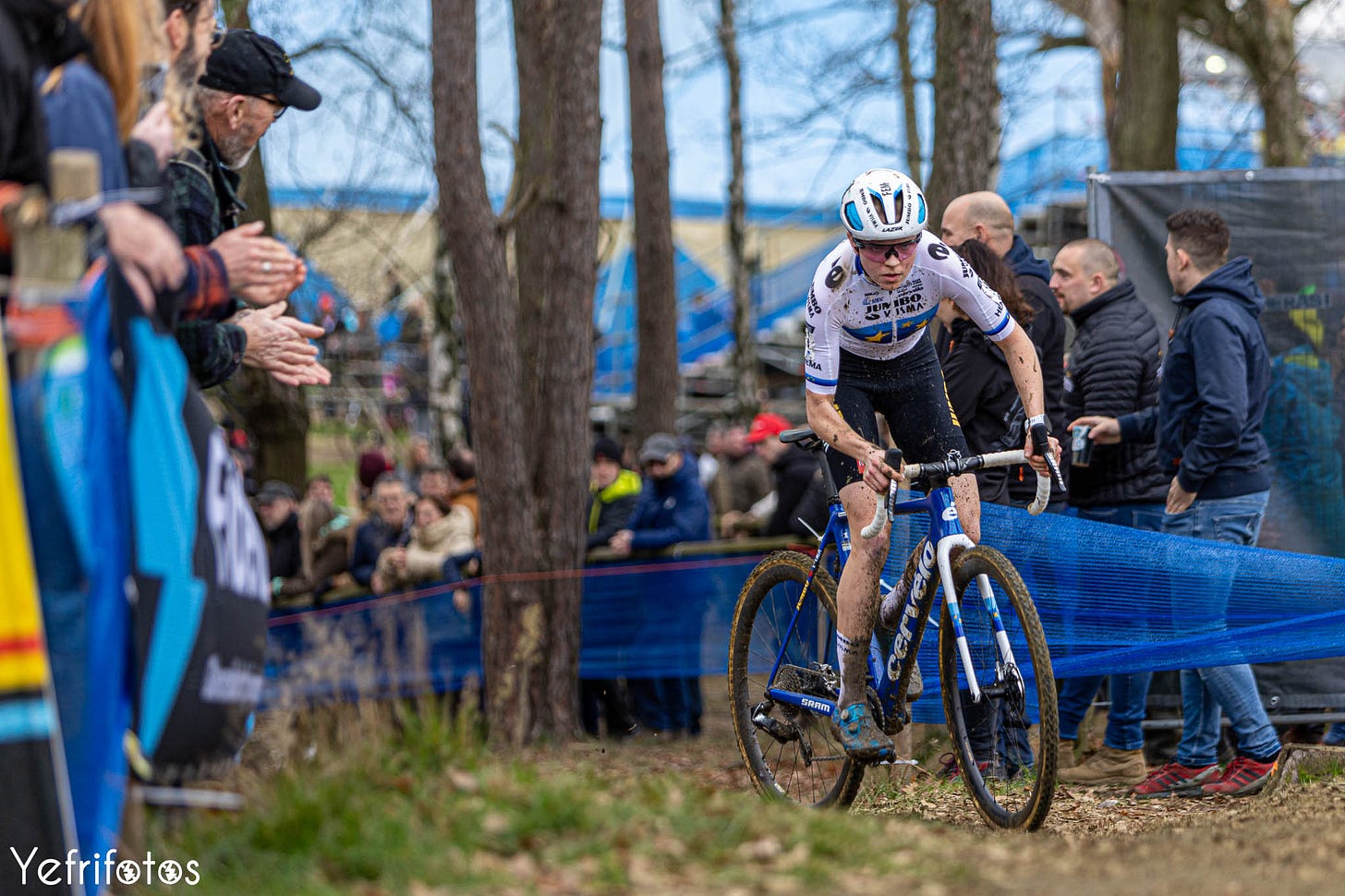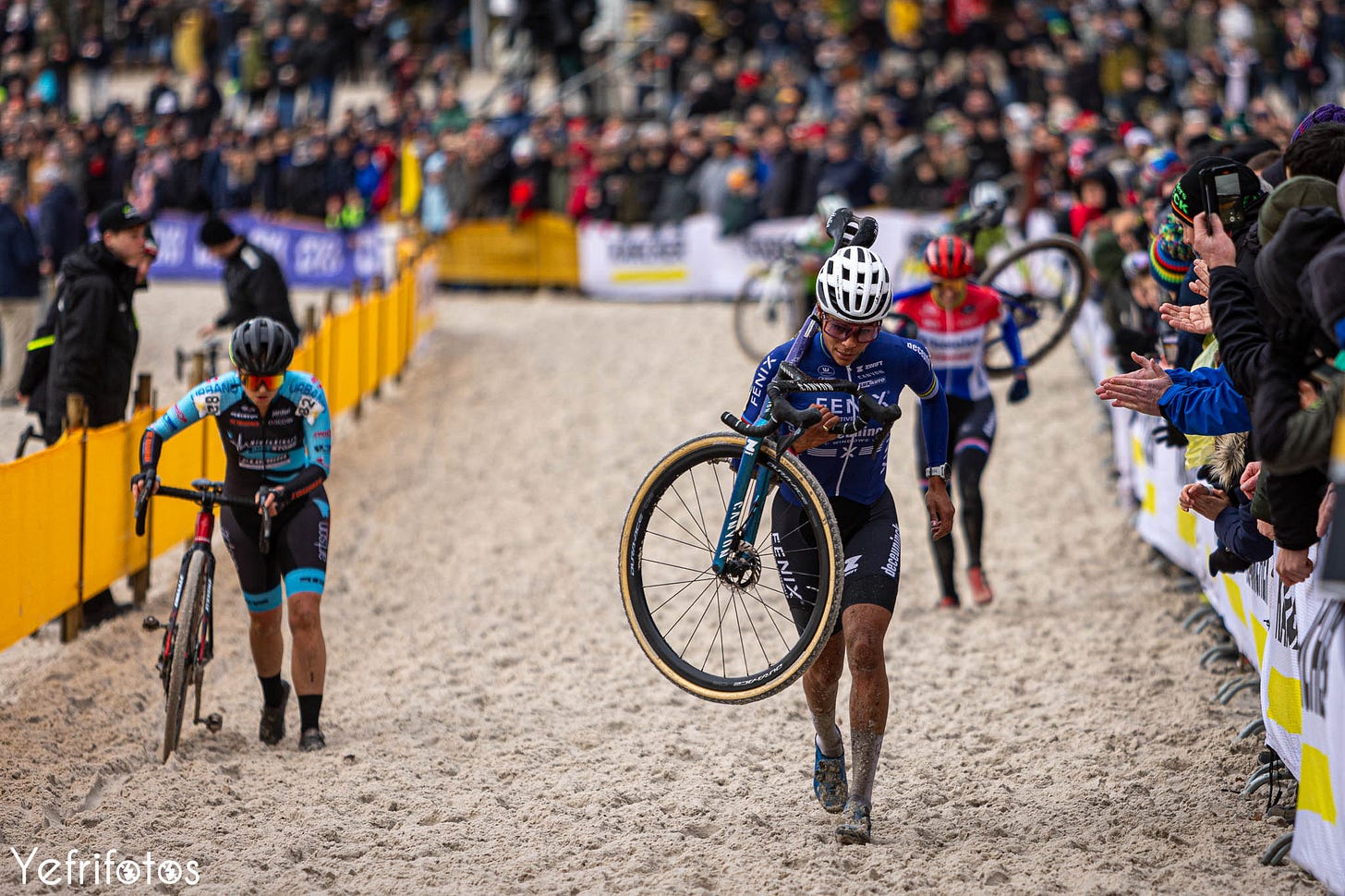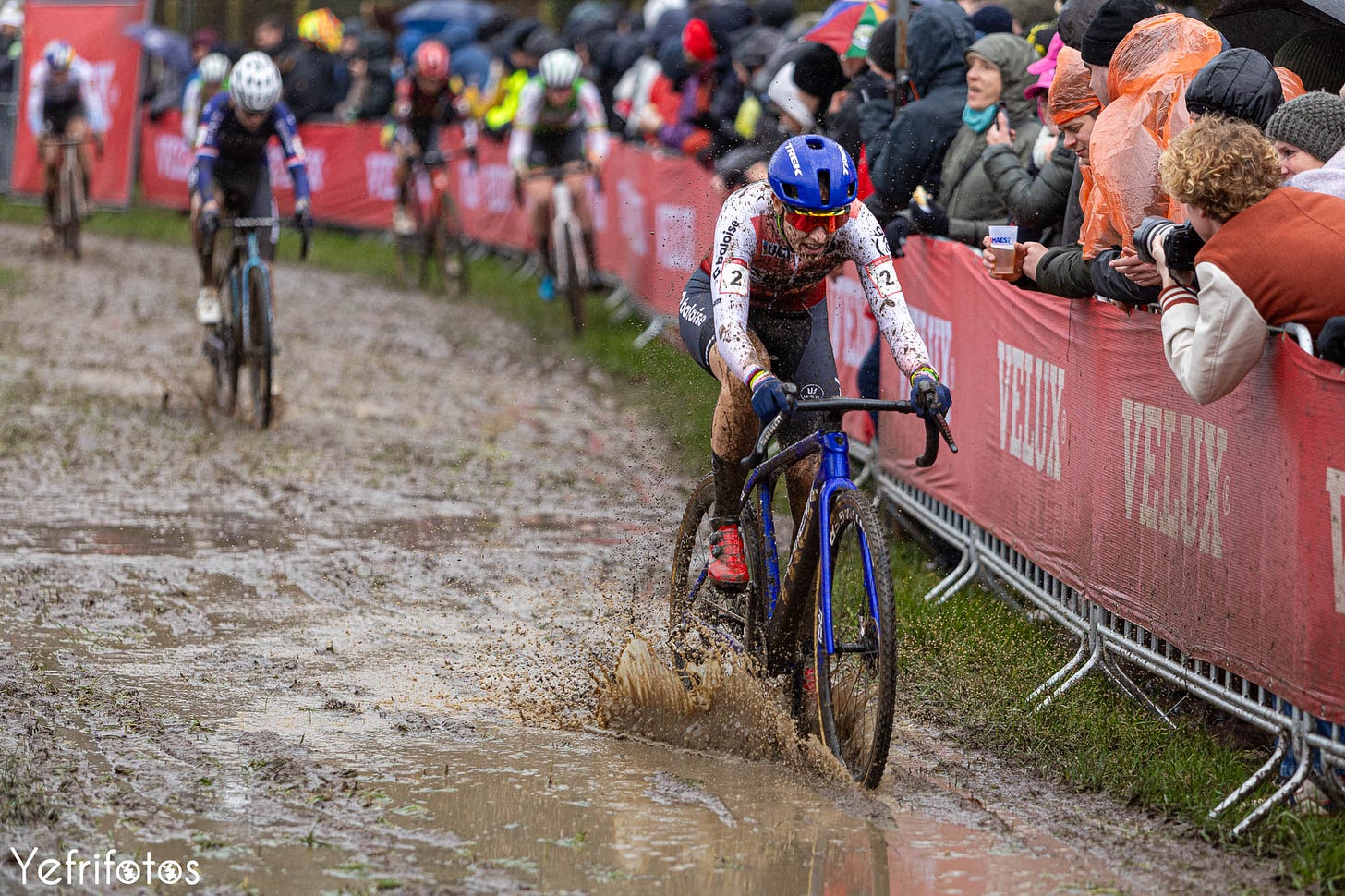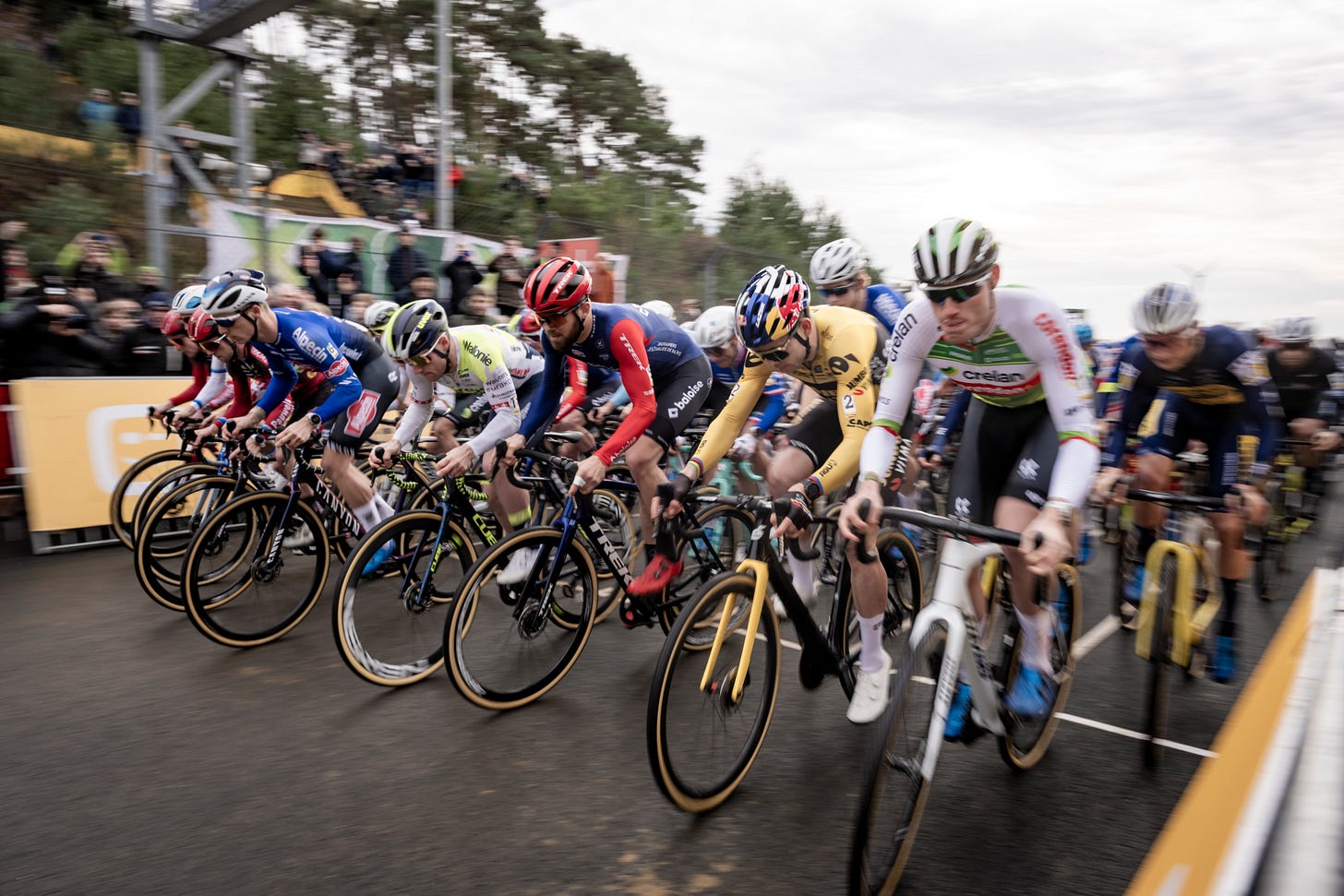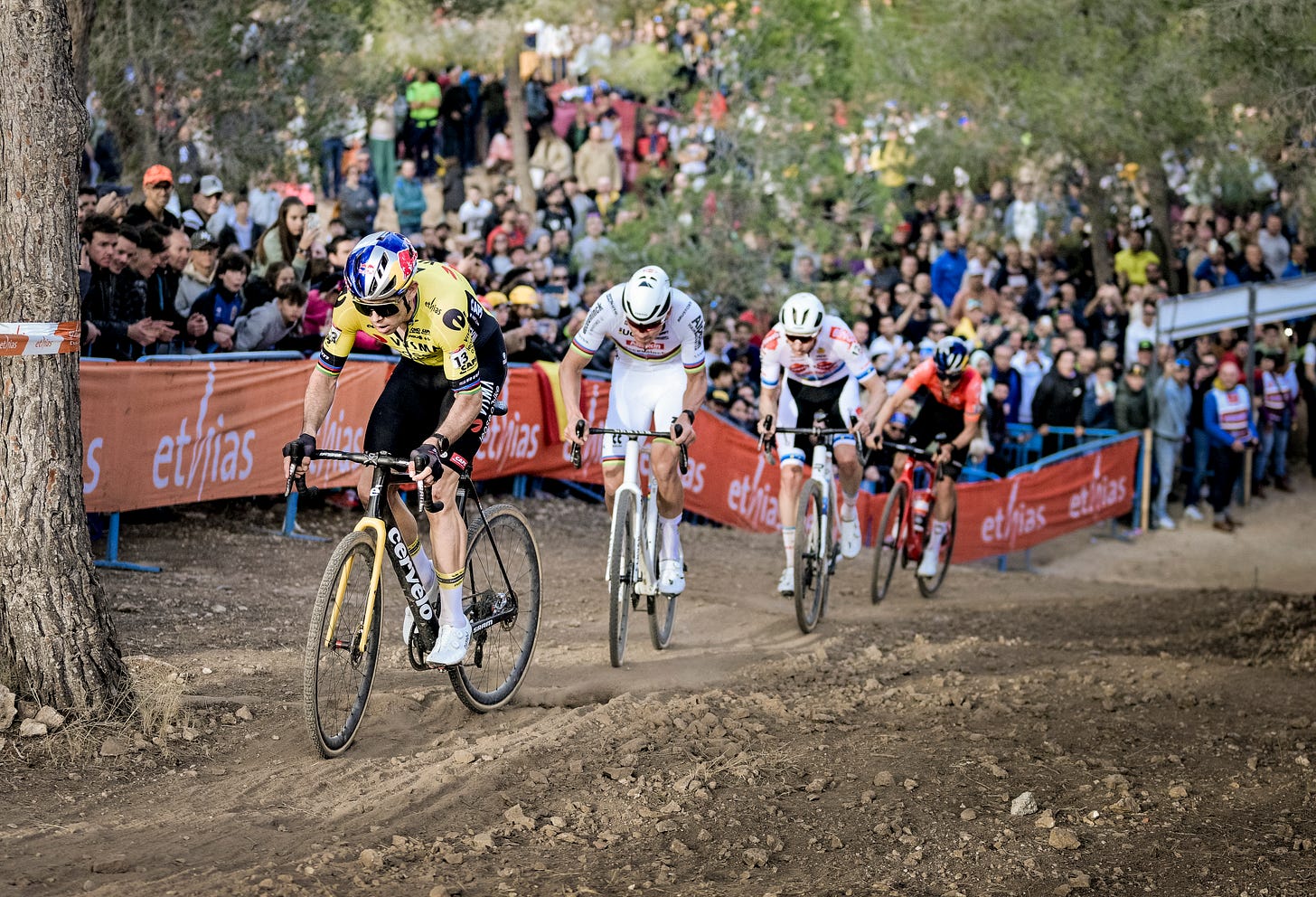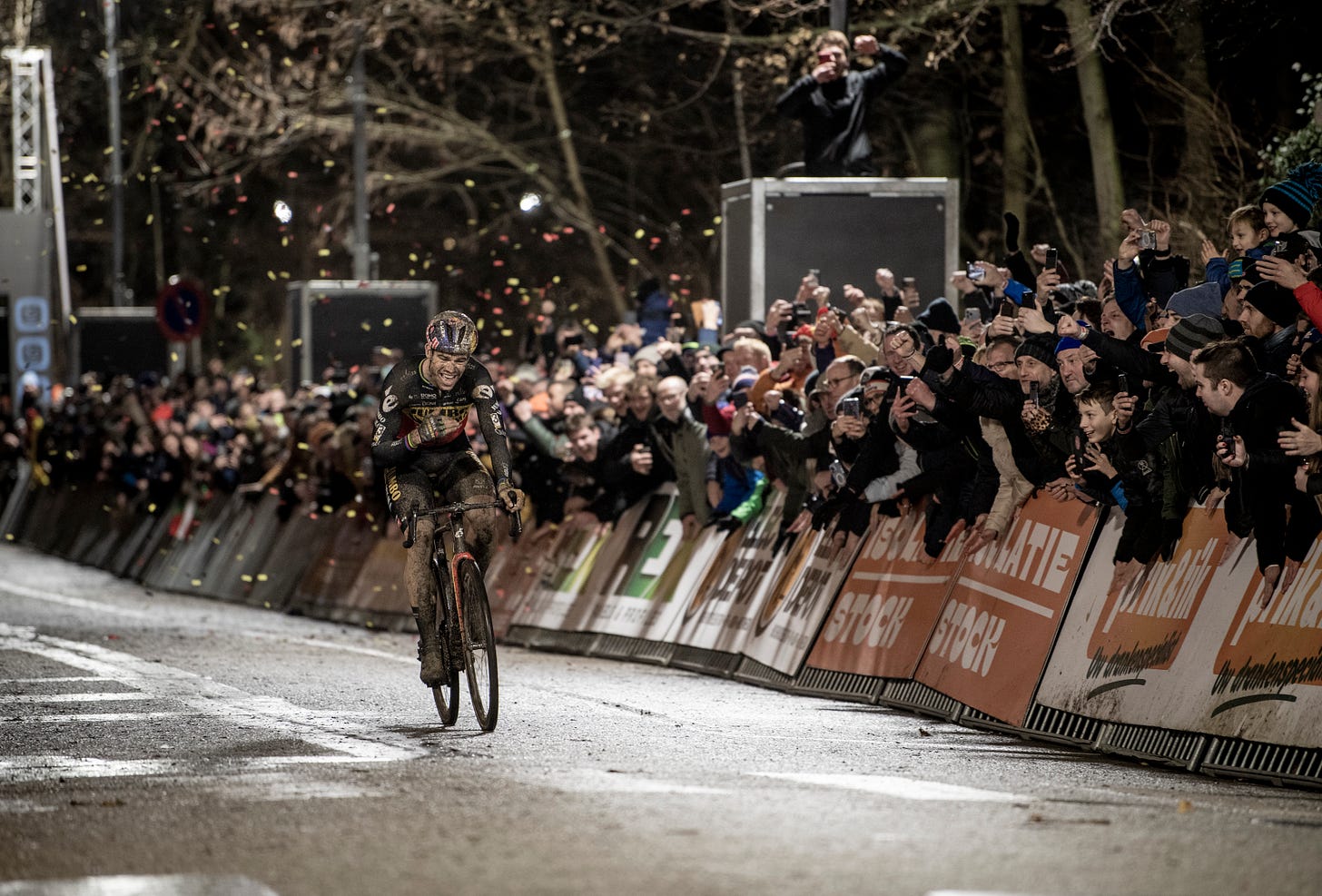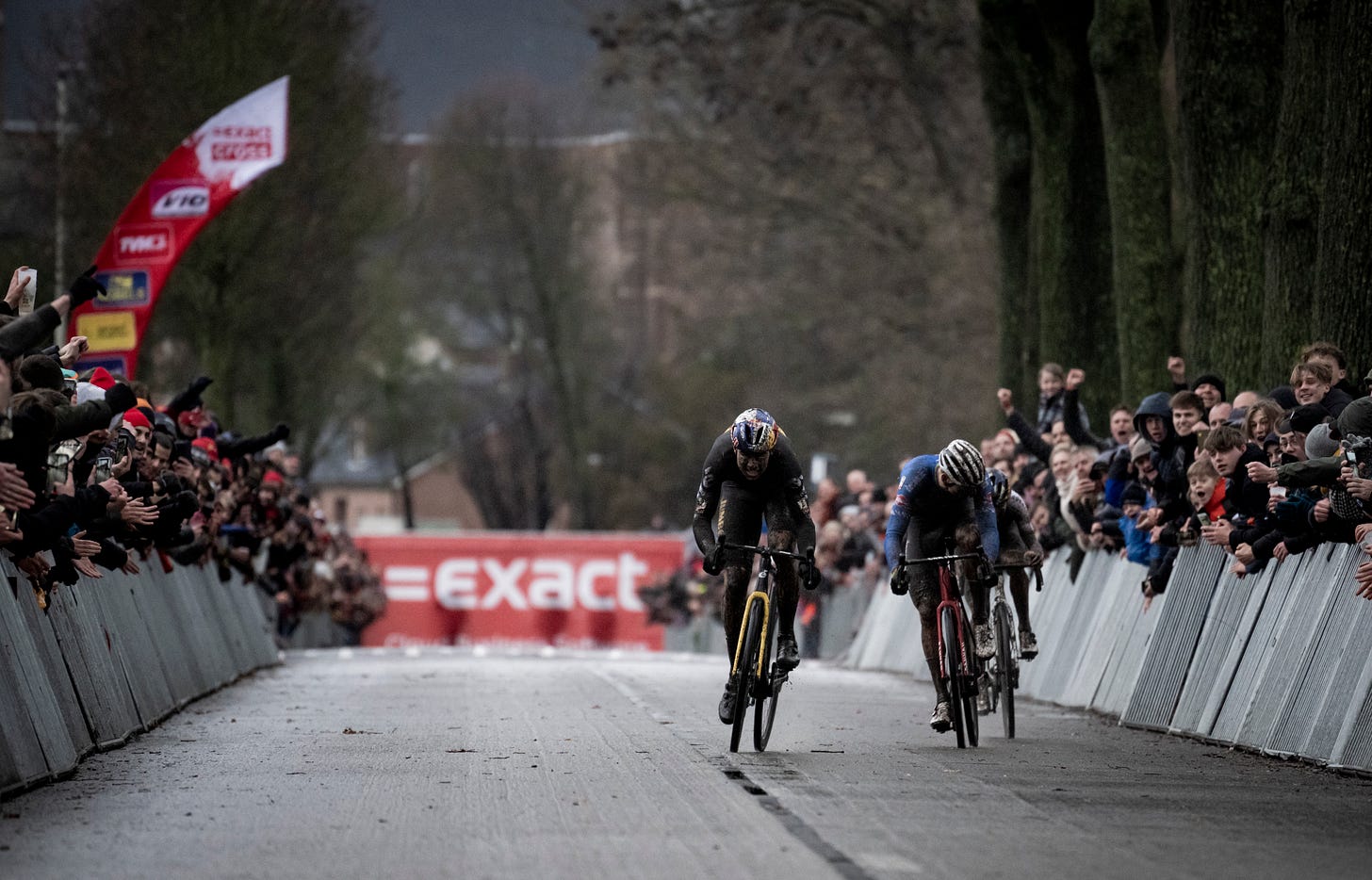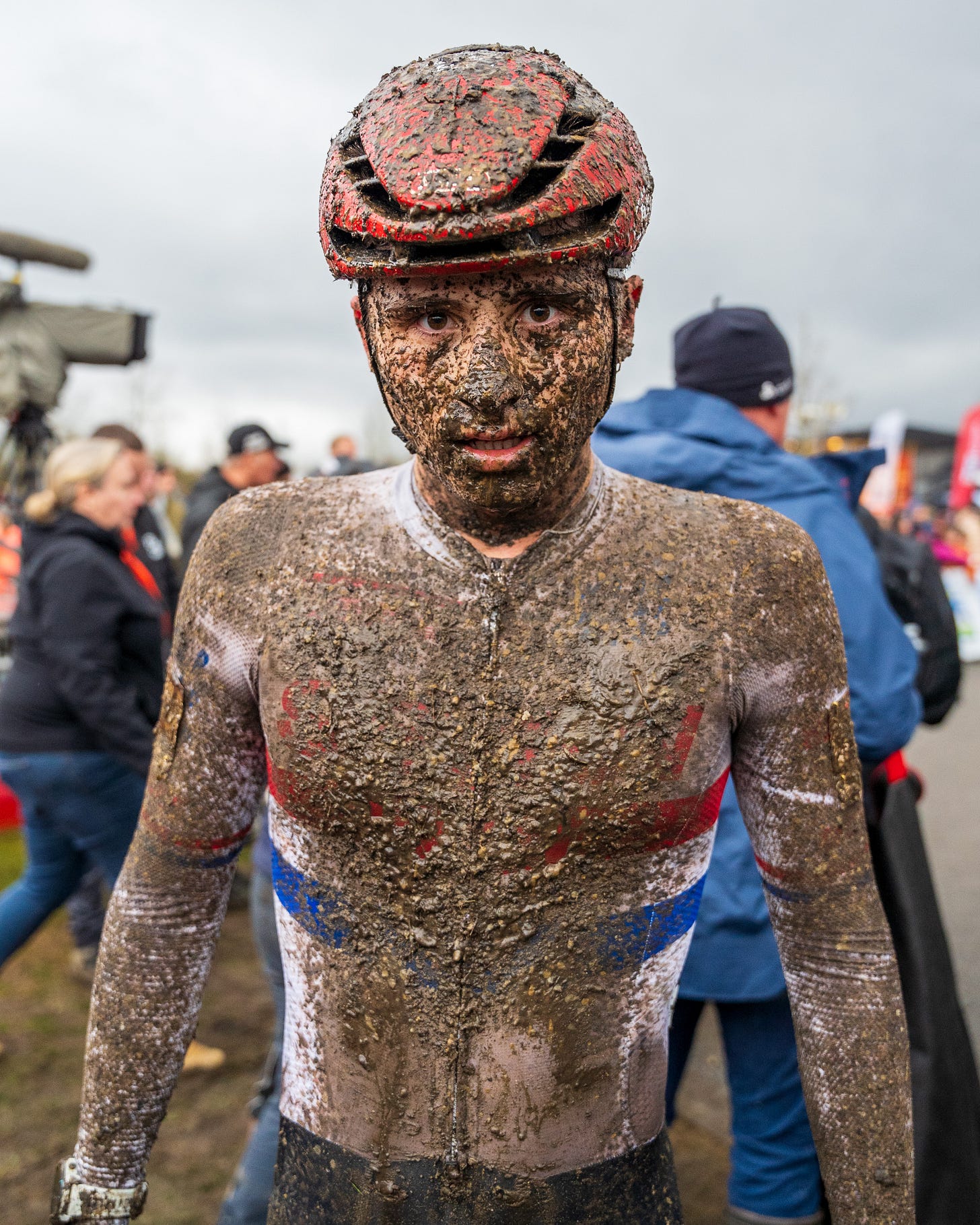Inside Cyclocross #43
More races, more problems. In this edition of Inside Cyclocross we zoom in on the Cyclocross Christmas Crunch and discuss how a beloved tradition transformed into an unmanageable festive calendar
The big problem with the Cyclocross Calendar
After nearly two decades of absence, Hofstade is returning to the cyclocross calendar this winter! While reactions to the return of the iconic sand course were mostly positive, it’s yet another cyclocross race added to the already busy Christmas period. The conflicting interests of riders and race organizers is becoming a bigger issue, such that UCI intervention might be necessary.
By Noah van Putten
Yefri went into the water to get us this shot, real dedication - YefriFotos
A few weeks ago, Belgian newspaper Gazet van Antwerpen announced that Hofstade is returning to the cyclocross calendar this winter. After an absence of nearly 20 years, Golazo is stepping in to organize a round of the X2O Trophy on the Sport Vlaanderen beach, which previously hosted four World Cups.
The announcement was met with mostly positive reactions. Hofstade was a beloved course back in the day. The sand sections along the lake are extremely challenging, immediately making it the second most sand-heavy venue on the calendar - second only to Koksijde. The rest of the course has a nice flow, spectator turnout was always strong, and it adds a layer of nostalgia for long-time cyclocross fans.
Hofstade was a true pioneer in terms of course design. It was the first major race to set its course along the banks of a recreational lake. The balance between sand and grass it introduced has since become a common course format. Races in Heerde, Mol, Sint-Niklaas, and Lille all followed the standard set by Hofstade. Even internationally, the course design is found everywhere. Races in Brumath, As Pontes and Varberg take place on similar courses.
Even in the snow, Lille still looks a bit like Hofstade - YefriFotos
Sven Nys won three of the four World Cups held in Hofstade in dominant fashion, but the one edition he didn’t win has been described as a modern classic. The eleven-lap race turned into a heated battle between the two strongest cyclocross teams of the time: Rabobank and Telenet-Fidea. The leading group of nine riders included four from Telenet and five from Rabobank.
For most of the race, Telenet dictated the pace. They deployed aggressive team tactics, taking turns attacking with Peter Dlask, Bart Wellens, and World Champion Erwin Vervecken. Rabobank was on the defensive, but strong domestique work by Gerben de Knegt and Sven Vanthourenhout kept Sven Nys in contention. The race went back and forth, but eventually, the relentless Telenet attacks wore Nys down. Vervecken broke clear going into the final lap and took the win ahead of Dlask and Thijs Al, who had recovered well from a poor start.
When the race was discontinued in 2008, it wasn’t due to financial problems. The course was a fan favorite that consistently drew large crowds. However, the organizers caused more environmental damage to the venue than was permitted, leading the city council to increase the organizing fee to cover restoration costs. Unwilling to pay what they considered a fine, the organizers packed up and moved the World Cup to the nearby motorcircuit of Heusden-Zolder.
Zolder replaced Hofstade - Kristof Ramon / Red Bull Content Pool
In that sense, it’s no surprise that the return of Hofstade has been welcomed. What has gone somewhat overlooked, however, is that this race will become the 12th Belgian Christmas race of the season. Between December 20 and January 4, 12 races will take place in just 16 days. While the Christmas period has traditionally been the busiest part of the season, the addition of Hofstade highlights a broader trend: the festive season is becoming more crowded than ever.
Until 1995, there were typically between four and six Belgian races during the Christmas period. At that time, cyclocross was more international. The Superprestige still functioned as a mini-World Cup, with races across Europe. High-level events were held in Italy, Switzerland, and the Netherlands during the holidays. For instance, in 1998, several top riders competed in Hombrechtikon, Switzerland, just before New Year’s eve. Now, that’s unthinkable, unless a World Cup takes place outside of Belgium - see Besançon and Hulst last year.
The Christmas period is busier than ever - Kristof Ramon / Red Bull Content Pool
In the early 2000s, the epicenter of cyclocross shifted to Belgium. Non-Belgian Christmas races began to disappear, leading to a gradual increase in the number of Belgian races. From 2000 to 2020, there were usually seven or eight Christmas-period races, depending on whether the World Cup went to Rome, Zeddam or Belgium. Since the COVID era, however, that number has rapidly increased. In 2022, there were 10 Christmas races. This season, Hofstade becomes the 12th day of Christmas (racing).
Number of Belgian cyclocross races in festive season
While this expansion is great for fans who enjoy watching cyclocross on a daily basis, the stampede of race organizers toward the Christmas period negatively impacts the riders. This winter, Laurens Sweeck told Het Nieuwsblad:
“In my first professional years, the race in Baal on January 1st was traditionally the end of the busy period. That is no longer the case. We’ve had three tough races between Baal and the Belgian Championship. Those are all part of classifications, so it’s actually asking riders to skip races.”
Fem van Empel racing in Baal a few seasons ago - YefriFotos
Sweeck hit on the core issue with his remark about classified races. While the addition of four races already marks a sharp 50% increase in Belgian Christmas races, the jump is even more striking when focusing on classification events. Between 2010 and 2020, there were consistently six classification races over the Christmas period. This year, there will be eleven.
Cyclocross races in Belgium over Christmas counting to big 3 series over time
The increase looks especially sharp in the figure above, but is actually a trend that already set in last year. Over Christmas, the World Cup hosted two rounds outside of Belgium, namely in Hulst and Besançon. If you account for these races, there were eleven Christmas races last season, of which ten counted toward one of the three major classifications (X2O, Superprestige, and World Cup). In that sense, Hofstade is just another brick in the wall.
Mol will remain on the calendar for 2025-2026 as well - YefriFotos
A common defense of the packed Christmas schedule is that riders aren’t forced to compete in every race, they’re free to skip events if they choose. While technically true, this argument overlooks several key nuances.
First, the financial structure of cyclocross is complicated. Riders do receive salaries from their teams, but a large part of their earnings is incentive-based. Base salaries in cyclocross are relatively low because riders keep their prize money and often receive starting fees. Skipping Christmas races means forfeiting not only that start and prize money, but, more importantly, the earnings tied to overall classifications. The three major series are the most lucrative, with over €25,000 on offer for the winner. The increasingly packed schedule forces riders to choose between protecting their long-term form or chasing financial rewards. Six classified Christmas races were already at the limit of what riders could realistically recover from. With eleven, it’s nearly impossible to race them all and still perform well at the National and World Championships later in January.
By Dendermonde, everyone was on their last feet last year - YefriFotos
And it’s not just the riders who suffer, the races themselves are also affected. While there are enough riders to fill the start lists, the quality of those lists varies greatly. Loenhout, the only non-classified race during the Christmas period, is an obvious example. In recent years, it has featured particularly weak women’s fields. But it’s not just Loenhout, several classified races have also seen thin fields beyond the big-name stars. All X2O races, along with the women’s Superprestige events, have experienced noticeable drop-offs in quality past the top contenders. This not only affects the individual race promoters, but also weakens the prestige and competitiveness of the series as a whole.
Nevertheless, race series are increasingly shifting their events toward the Christmas period. Most of that recent growth can be attributed to the World Cup. With their latest reform in 2024, the number of World Cup races held over the holidays rose to five - an increase from the traditional two or three during that time.
The increased number of Christmas World Cups is a double-edged sword. On one hand, the intent is to encourage multidisciplinary riders to compete for the overall World Cup win by concentrating the schedule around the holiday period. This approach had some positive effects last season: Blanka Vas, Marie Schreiber, and Zoe Bäckstedt committed to the full series, though most would have skipped the eventually cancelled round in Cabras. Fem van Empel raced nine of the final eleven rounds, showing strong commitment, but there was little real competition for the overall. Lucinda Brand secured the title with ease, something that could be avoided with a more balanced points system, as the current one is too top-three heavy.
Still, the hope that multidisciplinary stars will fully target the World Cup remains largely wishful thinking. While Mathieu van der Poel finished fourth in the standings, he only raced five rounds. With the current points system, Van der Poel - or Wout van Aert, for that matter - could potentially win the overall classification with a limited number of appearances. Van der Poel likely would have taken the overall crown had he raced Dendermonde and Benidorm. While having a big name win the series may look good on paper, it also highlights the underlying problem: for a rider of Van der Poel’s caliber, winning the cyclocross World Cup holds little value. His ambitions lie above and beyond. Securing the title after racing just half the rounds might offer a nice (financial) bonus, but it would also be somewhat tragic as it emphasizes how little the series means to the sport’s biggest stars.
Ready, Set, Go - Kristof Ramon / Red Bull Content Pool
While the overall World Cup classification still hold value, that can’t be said for the other classifications. The women’s X2O Trophy has only seen a close battle once in the past decade (during the 2020–2021 season), and the men’s edition hasn’t attracted consistent commitment from top riders either. In most editions, there were two or three riders interested in competing for the series. We’ve previously covered the reasons behind this, but this season the women’s Superprestige showed similar signs of decline. The title fight between Lucinda Brand and Ceylin del Carmen Alvarado remained intriguing throughout most of the season, yet very few riders committed to the full series. Notably, Fem van Empel finished 10th overall despite only racing the first two rounds in Ruddervoorde and Overijse.
The rise of multidisciplinarity among riders is a major factor here. Riders are starting their seasons later, taking mid-season breaks for training camps, and ending their CX campaigns earlier. A broader shift in mentality around racing frequency is also at play. During the Nys era, it was normal to race around 40 times per season. That’s no longer the case. The intensity of modern cyclocross, minimum one hour of full-throttle effort, has further increased due to more explosive course designs. Combined with a shift in focus from racing volume to training quality, this has led to more selective race calendars for most full-time cyclocross riders.
High stakes racing in Benidorm - Kristof Ramon / Red Bull Content Pool
That riders increasingly prioritize World Cup events over the X2O and Superprestige races is fully rational. The World Cup is, and should be, the sport’s premier series. The UCI points and prize money available in World Cups far exceed those in C1 and C2 events. Still, non-World Cup organizers (races and series) are often vocal in their frustration over top riders skipping their races.
But blaming riders for being picky in what races they do is unfair, it’s the structure of the current calendar that forces them to choose. Expecting riders to compete in 11 or 12 races over just 16 days is simply unrealistic. Anyone committing to that schedule is essentially signing off on a mortgage that will cost them the rest of their season. The cumulative fatigue from such a brutal stretch inevitably hampers performance at the sport’s two most important events: the national and world championships.
It would require a big push to race all Christmas races - BeyondHorizonMedia
So why do so many organizers still push to schedule their events during the Christmas period, despite all the downsides? The answer boils down to two names: Mathieu van der Poel and Wout van Aert. While the festive season has always been commercially appealing, fans are off work and eager to attend races, the presence of these two riders creates a superstar effect. Races without them can still attract solid crowds of over 10,000 (see Koppenberg and Niel), but Van der Poel and Van Aert have a star power that transcends core cyclocross audiences. Their head-to-head battles during the holidays routinely bring in more than 20,000 fans on-site.
Do the math: if the average attendee spends €35 on tickets, beer, and fries, those extra 10,000 spectators represent a €350,000 revenue boost. Even after paying appearance fees rumored to be €20,000 per rider, organizers come out ahead by a wide margin. With Van der Poel and Van Aert now condensing their cyclocross seasons to just over a month, running from December into the World Championships, organizers have every incentive to schedule their events during that same period.
Over 25,000 fans were in Diegem to see Van Aert take on Van der Poel in 2022 - Kristof Ramon / Red Bull Content Pool
Series organizers are effectively undermining the seasonal appeal of their own classifications to cater to the schedules of Van der Poel and Van Aert. While this might make financial sense for individual races, they can’t have it both ways. If they want to profit from superstar appearances, they shouldn’t complain about the declining prestige of their series, riders skipping their races, and the increasingly shallow start lists over Christmas.
Ironically, the growing number of Christmas races also makes it harder for organizers to secure participation of both Van Aert and Van der Poel. All organizers dream of hosting a showdown between the two, ideally with Tom Pidcock or Thibau Nys added to the mix. But whole more races increases demand, the supply remains limited to just two riders. Van der Poel and Van Aert won’t come close to racing all 12 Christmas events, which means they can increase their starting fee. In the end, most races sign only one of the two for the race, which, in turn, reduces the number of times they face each other. This to the disappointment of fans, who want to see the two best riders face off as often as possible.
All races want scenes like this - Kristof Ramon / Red Bull Content Pool
While these problems may seem like concerns only for race organizers, their decisions have real consequences for full-time cyclocross riders. Not only do riders miss out on income, but the early-season cyclocross calendar is also becoming increasingly sparse. The traditional pre-season shakedowns in August are long gone, and now all September races have disappeared too. Even in October (four races) and November (five), the number of televised Belgian cyclocross events is limited. This reduced visibility makes it harder for sponsors to justify supporting full-time cyclocross teams, threatening the sustainability of full time cyclocross riders’ careers.
Cyclocross at Christmas is becoming the All I Want for Christmas Is You of the festive season. It’s everywhere you turn, whether you like it or not. And just like the radio DJs who quietly dread Mariah Carey’s return, many riders aren’t exactly thrilled about the overloaded holiday schedule. Twelve races in sixteen days is simply too much, especially with two quadruple-headers packed into that stretch.
Cyclocross riders looking at the Christmas schedule - BeyondHorizonMedia
To better protect the interests of full-time cyclocross riders and teams, the UCI should implement a cap on how many races can be organized within a single country in one week. They should also lead by example and scrap at least one of the five Christmas World Cups. The protected status of World Cup weekends should also be used to break up the stretches of four races in a row, creating breathing room for riders. Together, this should bring the Christmas block back to a more manageable number of eight races.
To spread the benefits of organizing during this time of year, race organizers should engage in dialogue to find a compromise. Golazo and Flanders Classics, who control most of the races in that stretch, could implement a rotation system in which some events to shift to early-season slots in one year, then return to the coveted Christmas period the next. That would strike a more balanced compromise between the interests of riders and organizers, unlike the current setup where the profit maximizing mentality of organizers and event agencies dominate the agenda.

